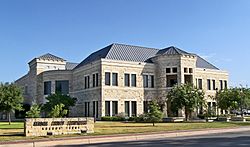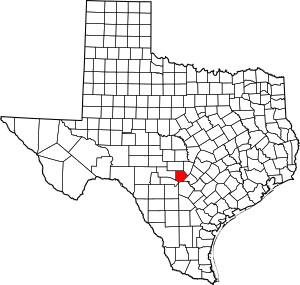Kendall County, Texas facts for kids
Quick facts for kids
Kendall County
|
||
|---|---|---|

The Kendall County Courthouse in Boerne
|
||
|
||

Location within the U.S. state of Texas
|
||
 Texas's location within the U.S. |
||
| Country | ||
| State | ||
| Founded | 1862 | |
| Named for | George Wilkins Kendall | |
| Seat | Boerne | |
| Largest city | Boerne | |
| Area | ||
| • Total | 663 sq mi (1,720 km2) | |
| • Land | 662 sq mi (1,710 km2) | |
| • Water | 0.6 sq mi (2 km2) 0.09% | |
| Population
(2020)
|
||
| • Total | 44,279 | |
| • Density | 66.79/sq mi (25.786/km2) | |
| Time zone | UTC−6 (Central) | |
| • Summer (DST) | UTC−5 (CDT) | |
| Congressional district | 21st | |
Kendall County is a county located on the Edwards Plateau in the U.S. state of Texas. In 2020 census, its population was 44,279. Its county seat is Boerne. The county is named for George Wilkins Kendall, a journalist and Mexican–American War correspondent.
Kendall County is part of the San Antonio–New Braunfels, TX metropolitan statistical area.
Progressive Farmer rated Kendall County fifth in its list of the "Best Places to Live in Rural America" in 2006.
Kendall, along with Hays and Comal Counties, was listed in 2017 of the nation's 10 fastest-growing large counties with a population of at least 10,000. From 2015 to 2016, Kendall County, the second-fastest-growing county in the nation, grew by 5.16%, gaining 2,088 people in a one-year period.
Contents
History
Before 1850
- c. Early Native American inhabitants include Kiowa, Comanche and Lipan Apache.
- 1700s Lipan Apaches discover Cascade Caverns.
- 1842
- April 20 - Adelsverein organized in Germany to promote emigration to Texas.
- June 7 - Fisher-Miller Land Grant sets aside 3,000,000 acres (1.2×1010 m2) to settle 600 families and single men of German, Dutch, Swiss, Danish, Swedish, and Norwegian ancestry in Texas.
- 1844, June 26 - Henry Francis Fisher sells interest in land grant to Adelsverein.
- 1845
- Prince Carl of Solms-Braunfels secures title to 1,265 acres (5.12 km2) of the Veramendi grant, including the Comal Springs and River, for the Adelsverein.
- February - Thousands of German immigrants are stranded at port of disembarkation Indianaola on Matagorda Bay. With no food or shelters, living in holes dug into the ground, an estimated 50% die from disease or starvation. The living begin to walk to their destinations hundreds of miles away.
- May - John O. Meusebach arrives in Galveston.
- December 20 - Henry Francis Fisher and Burchard Miller sell their rights in the land grant to Adelsverein.
- 1847
- Meusebach–Comanche Treaty
- Sisterdale established.
- 1849 Freethinkers Bettina colonists from Llano County settle Tusculum, named after Cicero’s home in ancient Rome. The initial community bans any churches from being erected. The town is later re-named Boerne, for German-Jewish political writer Ludwig Börne, who influenced Karl Marx.
1850-1899
- 1850s George W. Kendall introduces sheep ranching to the County.
- 1854
- John O. Meusebach receives an appointment as commissioner from Governor Elisha M. Pease
- May 14–15, San Antonio - The Texas State Convention of Germans adopt a political, social and religious platform, including: 1) Equal pay for equal work; 2) Direct election of the President of the United States; 3) Abolition of capital punishment; 4) "Slavery is an evil, the abolition of which is a requirement of democratic principles.."; 5) Free schools – including universities - supported by the state, without religious influence; and 6) Total separation of church and state.
- Comfort is founded by German immigrant Freethinkers and abolitionists.
- 1860 Boerne Village Band is formed by Karl Dienger.
- 1861 Unionists from Kerr, Gillespie, and Kendall counties participate in the formation of the Union League, a secret organization to support President Abraham Lincoln’s policies.
- 1862
- Kendall County is established from Kerr and Blanco counties, named for journalist George Wilkins Kendall. Boerne is the county seat.
- The Union League forms companies to protect the frontier against Indians and their families against local Confederate forces. Conscientious objectors to the military draft are primarily among Tejanos and Germans .
- May 30 – Confederate authorities impose martial law on Central Texas.
- August 10 - Nueces massacre in Kinney County. Jacob Kuechler serves as a guide for 61 conscientious objectors attempting to flee to Mexico. Scottish born Confederate irregular James Duff and his Duff’s Partisan Rangers pursue and overtake them at the Nueces River, 34 are killed, some executed after being taken prisoner.Jacob Kuechler survives the battle. The cruelty shocks the people of Gillespie County. 2,000 take to the hills to escape Duff's reign of terror.
- Spring Creek Cemetery near Harper in Gillespie County has a singular grave with the names Sebird Henderson, Hiram Nelson, Gus Tegener and Frank Scott. The inscription reads "Hanged and thrown in Spring Creek by Col. James Duff’s Confederate Regiment."
- 1866 Samuel Boyd Patton was elected chief justice after his home became part of Kendall county which was Blanco County.
- 1866, August 10 - Treue der Union Monument ("Loyalty to the Union") in Comfort dedicated to the German Texans slain at the Nueces massacre.It is the only monument to the Union outside of the National Cemeteries on Confederate territory. It is one of only six such sites allowed to fly the United States flag at half-mast in perpetuity.
- 1870 Original Kendall County limestone courthouse built. Italianate architecture. Architect Philip Zoeller and J. F. Stendebach.
- 1885
- Austrian-born Andreas Engel founds Bergheim.
- Sisterdale cotton gin begins operations.
- 1887 San Antonio and Aransas Pass Railway begins Boerne to San Antonio route.
- 1897, May 27 - John O. Meusebach dies at his farm at Loyal Valley in Mason County, is buried in the Marschall Meusebach Cemetery at Cherry Spring.
1900-present
- 1900 Kendall County has 542 farms. Area has risen from 153,921 acres (622.90 km2) in 1880 to 339,653 acres (1,374.53 km2). Stockraising is still the principal industry.
- 1905 Citizens of Boerne gather together to share agricultural information, recipes, and news of events. This later became the annual Kendall County Fair.
- 1913 The Kendall County Fair Association was organized and was awarded a nonprofit corporate charter from the State of Texas.
- 1914 Fredericksburg and Northern Railway connects Fredericksburg with the San Antonio and Aransas Pass Railway track just east of Comfort.
- 1918 Hygieostatic Bat Roost house built in Comfort to attract bats to eradicate mosquitoes and reduce the spread of malaria. Designed for former San Antonio Mayor Albert Steves Sr., by bat authority Dr. Charles A. R. Campbell.
- 1930’s
- The Great Depression brings increase in tenant farming.
- Commercial development of Cascade Caverns begins.
- World War II - American Military bases in the San Antonio area provide jobs for Kendall County residents.
- 1983 Guadalupe River State Park opens to the public.
- 1988 Federal Republic of Germany recognizes the Boerne Village Band for its contribution to the German heritage in Texas and America.
- 1990, Earth Day – Cibolo Nature Center opens to the public.
- 1991 Texas legislature adopts a resolution recognizing the Boerne Village Band for "keeping alive German music as a part of our heritage."
- 1998 Current Kendall County limestone, steel and concrete courthouse built in Boerne, across the street from the original 1870 courthouse. Architect Rehler Vaughn & Koone, Inc.
- 2005 Kendall County celebrates its 100th anniversary of the Kendall County Fair. The Kendall County Fair Association continues to produce one of the few remaining entirely privately funded county fairs in the state of Texas.
- 2013 The Kendall County Fair Association, Inc. celebrates its 100th year of existence.
- 2015 Kendall County declares a State of Emergency from May flooding.
Geography
According to the U.S. Census Bureau, the county has a total area of 663 square miles (1,720 km2), of which 662 square miles (1,710 km2) is land and 0.6 square miles (1.6 km2) (0.09%) is water.
Major highways
 Interstate 10
Interstate 10 U.S. Highway 87 (Old Spanish Trail)
U.S. Highway 87 (Old Spanish Trail) U.S. Highway 87 Business (Old Spanish Trail)
U.S. Highway 87 Business (Old Spanish Trail) State Highway 27 (Old Spanish Trail)
State Highway 27 (Old Spanish Trail) State Highway 46
State Highway 46 Farm To Market Road 289 (Old Spanish Trail)
Farm To Market Road 289 (Old Spanish Trail) Farm to Market Road 1621
Farm to Market Road 1621 Farm to Market Road 3351
Farm to Market Road 3351 Ranch to Market Road 473
Ranch to Market Road 473 Ranch to Market Road 474
Ranch to Market Road 474 Ranch to Market Road 1376
Ranch to Market Road 1376 Ranch to Market Road 3160 (Formerly part of FM 3351)
Ranch to Market Road 3160 (Formerly part of FM 3351)
Historic highways
Adjacent counties
- Gillespie County (north)
- Blanco County (northeast)
- Comal County (southeast)
- Bexar County (south)
- Bandera County (southwest)
- Kerr County (west)
Waterways
- Guadalupe River
- Boerne Lake
- Browns Creek
- Block Creek
- Spring Creek
- Flat Rock Creek
- West Sister Creek
- East Sister Creek
- Sister Creek
- Wemer Creek
- Jacobs Creek
- Curry Creek
- First Coffee Hollow
- Dry Creek
- Sheps Creek
- Ralls Creek
- Ross Creek
- Black Creek
- Pleasant Valley Creek
- Polecat Spring Creek
- Joshua Creek
- Zinke Creek
- Holliday Creek
- Lake Oz
- Postroak Creek
- Deep Hollow Creek
- Menger Creek
- Kww Ranch Lake
- Masters Lake
- Smith Investment company lake number 1
- 711 Ranch Lake
- Goss Creek
Caves
- Cave Without a Name
- Spring Creek Cave
- Prassell Ranch Cave
- Three Whirlpool Cave
- Cascade Caverns
- Pfeiffer's Water Cave
- Alzafar Water Cave
- Reed Cave
Demographics
| Historical population | |||
|---|---|---|---|
| Census | Pop. | %± | |
| 1870 | 1,536 | — | |
| 1880 | 2,763 | 79.9% | |
| 1890 | 3,826 | 38.5% | |
| 1900 | 4,103 | 7.2% | |
| 1910 | 4,517 | 10.1% | |
| 1920 | 4,779 | 5.8% | |
| 1930 | 4,970 | 4.0% | |
| 1940 | 5,080 | 2.2% | |
| 1950 | 5,423 | 6.8% | |
| 1960 | 5,889 | 8.6% | |
| 1970 | 6,964 | 18.3% | |
| 1980 | 10,635 | 52.7% | |
| 1990 | 14,589 | 37.2% | |
| 2000 | 23,743 | 62.7% | |
| 2010 | 33,410 | 40.7% | |
| 2020 | 44,279 | 32.5% | |
| U.S. Decennial Census 1850–2010 2010 2020 |
|||
| Race / Ethnicity (NH = Non-Hispanic) | Pop 2000 | Pop 2010 | Pop 2020 | % 2000 | % 2010 | % 2020 |
|---|---|---|---|---|---|---|
| White alone (NH) | 19,104 | 25,746 | 31,767 | 80.46% | 77.06% | 71.74% |
| Black or African American alone (NH) | 63 | 138 | 315 | 0.27% | 0.41% | 0.71% |
| Native American or Alaska Native alone (NH) | 79 | 129 | 138 | 0.33% | 0.39% | 0.31% |
| Asian alone (NH) | 52 | 202 | 355 | 0.22% | 0.60% | 0.80% |
| Pacific Islander alone (NH) | 3 | 13 | 36 | 0.01% | 0.04% | 0.08% |
| Other Race alone (NH) | 31 | 26 | 202 | 0.13% | 0.08% | 0.46% |
| Mixed Race or Multiracial (NH) | 163 | 327 | 1,437 | 0.69% | 0.98% | 3.25% |
| Hispanic or Latino (any race) | 4,248 | 6,829 | 10,029 | 17.89% | 20.44% | 22.65% |
| Total | 23,743 | 33,410 | 44,279 | 100.00% | 100.00% | 100.00% |
As of the census of 2010, 33,410 people, 8,613 households, and 6,692 families resided in the county. The population density was 36 people per square mile (14 people/km2). The 9,609 housing units averaged 14 units per square mile (5.4/km2). The racial makeup of the county was 92.86% White, 0.56% Native American, 0.35% African American, 0.23% Asian, 4.46% from other races, and 1.55% from two or more races. About 17.89% of the population was Hispanic or Latino of any race.
Of the 8,613 households, 36.30% had children under the age of 18 living with them, 67.20% were married couples living together, 7.90% had a female householder with no husband present, and 22.30% were not families. About 19.20% of all households were made up of individuals, and 8.40% had someone living alone who was 65 years of age or older. The average household size was 2.70 and the average family size was 3.09.
In the county, the population was distributed as 27.20% under the age of 18, 6.10% from 18 to 24, 26.40% from 25 to 44, 26.40% from 45 to 64, and 13.90% who were 65 years of age or older. The median age was 39 years. For every 100 females, there were 95.00 males. For every 100 females age 18 and over, there were 91.40 males.
The median income for a household in the county was $49,521, and for a family was $58,081. Males had a median income of $39,697 versus $28,807 for females. The per capita income for the county was $24,619. About 7.90% of families and 10.50% of the population were below the poverty line, including 13.60% of those under age 18 and 9.40% of those age 65 or over.
Communities
Cities
- Boerne (county seat)
- Fair Oaks Ranch (partly in Bexar and Comal counties)
Census-designated place
Other unincorporated communities
- Alamo Springs
- Bergheim
- Kendalia
- Kreutzberg
- Lindendale
- Nelson City
- Oberly Crossing
- Pleasant Valley
- Sisterdale
- Waring
- Walnut Grove
Ghost towns
- Ammans Crossing
- Bankersmith
- Benton
- Block Creek (town)
- Currey's Creek
- Schiller
- Wasp Creek
- Welfare
- Windsor
Education
School districts include:
- Blanco Independent School District
- Boerne Independent School District
- Comal Independent School District
- Comfort Independent School District
- Fredericksburg Independent School District
All of the county is in the service area of Alamo Community College District.
Darmstadt Society of Forty
Count Castell of the Adelsverein negotiated with the separate Darmstadt Society of Forty to colonize two hundred families on the Fisher-Miller Land Grant territory in Texas. In return, they were to receive $12,000 in money, livestock, equipment and provisions for a year. After the first year, the colonies were expected to support themselves. The colonies attempted were Castell, Leiningen, Bettina, Schoenburg and Meerholz in Llano County; Darmstädler Farm in Comal County; and Tusculum in Kendall County. Of these, only Castell survives. The colonies failed after the Adelsverein funding expired, and also due to conflict of structure and authorities. Some members moved to other Adelsverein settlements in Texas. Others moved elsewhere, or returned to Germany.
See also
 In Spanish: Condado de Kendall (Texas) para niños
In Spanish: Condado de Kendall (Texas) para niños


